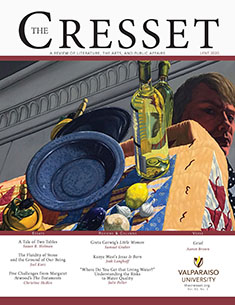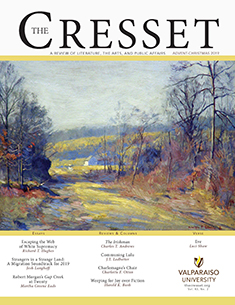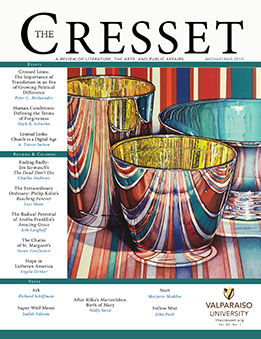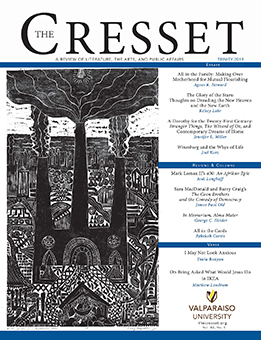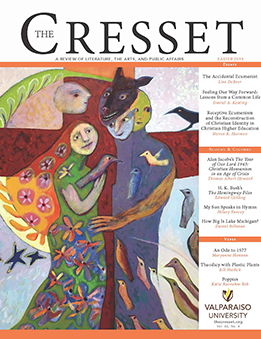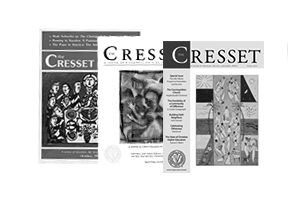The movie theater. In the light it has all the charm of the inside of a vacuum cleaner bag. The floors are sticky with spilled pop, used chewing gum, and decaying raisinettes. And there is an all-encompassing, penetrating silence that longs to end. That's the worst, the most uncomfortable, part of the entire waiting experience. Those of us who like to watch previews and the opening credits must endure it. It may be the acoustics of the place, unaccustomed to the absence of Dolby sound and the general movie noise, but I don't think so. Even when the theater is full of noisy, waiting people munching pop corn, the silence is still there, and it is waiting, as well.
In a movie theater, the silence ends when the pre-film crowd noise dims with the lights and darkness for a brief moment seems to rush into the room. The darkness ends the uncomfortable silence. We never feel a sensation of being out of the darkness until the end of the movie, when the lights are once again raised and the crowd files out, and the silence returns.
It is in this darkness that the whole world happens when we watch a movie, and it is this darkness we learn to welcome as children. We fear it at first because we know the power of the imagination to create dimensions that cross over into our own in which witches hide under beds, cruel spirits make their presence known through cracks in walls, and monsters threaten to break out of the closet and gobble us up. We knew the darkness best during the day when it surrounded us, helping us concentrate on our play-work. In these created worlds, we as children learn to willingly suspend our disbelief. We do it as adults, often in the theater. Though lately it's been taking us a goodly number of special effects to help us release our sense of reality. In the darkness, we find everything.
In learning to suspend our disbelief we begin to learn about belief, and thus form the basis of our own religious understanding. As children, we lack the language skills to learn solely from the printed word. But we do possess the skills of visual observation that enable us to learn most of what we will in our lifetimes before we enter kindergarten. Because of this, the image—especially the moving image, which mimics our world the way a child mimics an adult—takes an important role in development. As children, we know we are choosing to believe what is not real. Suspending our disbelief allows us to let the imagined exist alongside the real. As we grow in our understanding about the nature of belief, we learn to synthesize the symbolic and the concrete, giving them a symbiotic relationship in our lives. We voluntarily create—make real from what we have imagined—a faith.
But confusion arrests development. In a state of confusion, the real and the imagined fail to maintain an equilibrium. What may have been a rich, flexible faith might degenerate into a rigid and boring superstition in which belief and fact have no division, or result in an atheism which attempts to disprove belief. Writer Salman Rushdie, who is as famous for the death sentence imposed on him by the late Ayatollah Khomeni as he is for his writing, addresses the problem and the power of fear generated by the confusion between the real and the imagined in his novel for children, Haroun and the Sea of Stories. In it, he asks a question meant to explore the imagination's relationship to the real in a world where a storyteller's creations bring him political and religious persecution: "What's the use of stories that aren't even true?" Rushdie exposes the thinking of the adults of this world who read the Bible literally "on faith," or prevent their children from trick-or-treating for fear that such activity will lead them to become worshipers of Satan. Adults like these don't understand stories, he says. They don't understand the flexibility of creations, or how to ask questions of imagination. They live in an imaginary world themselves, he says, because they live with "truth," and without stories.
This message to children—that they can overcome their parents' blindness—that they somehow save the future from an imperfect present, that because of their desire for a unity between mundane life and the excitement of dreams, they represent the growing, evolving nature of faith— runs throughout Frances Hodgson Burnett's book, The Secret Garden. In it, she defines child abuse as a neglect of the spirit as well as of the body. The adults may be lost, she says to children, but you, though small and overlooked, are the hope, and you have voices.
Agnieszka Holland's film version of The Secret Garden, though secularized, still retains the forms of Burnett's original themes. In it, the children continually define the boundaries of existence by exercising curiosity as if it were an atrophied muscle. In their search for the seductive Secret Garden, they consciously ask life the reason for their existence. At ten, they have already found their meaninglessness in parental rejection. Mary has been forgotten by her parents and left to die in a fire following an earthquake, and later shipped off to a foreign land to live with people who consider her an inconvenience. In the scene in which she arrives in London, she could be a character out of Dickens, one of a million orphans destined to have to find her own way.
Colin's existence resembles an experiment. Holland illustrates his condition in contemporary terms, augmenting Burnett's descriptions of his treatment by subjecting him to a daily ordeal with a machine designed to keep his circulation consistent by use of electric shocks—the 19th century equivalent of a life-support system. His servants play the part of human i.v. bottles. They bury him in a tomb of a room whose atmosphere acts like morphine, depressing his faculties, shutting him off from contact with even the most benign of germs.
In The Secret Garden, man and woman return to Eden. There they succeed in their second chance, aided by their knowledge of good and evil. Having experienced hostile exile, they choose to live in a state of grace. As they reclaim the garden, the garden resurrects them from death. In The Secret Garden, vivacity and health mean roughly the same thing. Bodily growth is equivalent with spiritual growth. Health has a triple meaning. Body and spirit combine to create secure, happy children. Children are like flowers and plants, the movie tells us. Given the correct care, they flourish. They are capable of having intense, complete religious experiences.
Holland's film asks children to create a dialogue between the imaginary and the real as a way of fostering spiritual curiosity. The film is itself a secret garden, a medium with which children physically interact in order to answer their questions. They ask questions of the film the way Mary and Colin asked questions of their garden. The film responds in much the same way the garden does, and the children interpret it by suspending their disbelief.
This conversation between another reality and our own occurs on a collective level. The film speaks, and the audience behaves as if it were one being. In the movie theater, we react to the film with our bodies. We act with it, and therefore become a part of it. The noises and movements we make while still in our seats—the laughing or sobbing or screaming—reflect the unconscious relationship between the film and the individual, the individual and the audience, and the audience and the film. Indeed, the film-watching/film-living experience expects us to participate with the audience as in a worship experience. The film's reality creates the reality in which the audience exists for the length of the film. The camera acts as our eye and introduces us, as one person, to one perspective of all of life.
The film watches back. The camera of Cinema Paradiso, a film by Giuseppe Tornatore, records the life that flourishes within the darkness of the movie theater—love, sex, birth, death, blindness, illiteracy, passion— from the movie's viewpoint. It chronicles the story of a town and its movie theater through the life of one of the town's children, Salvatore, whose love of the Paradiso prompts him to search for its religious magic. Cinema Paradiso explains the connections between childhood, film, and religious development by subjecting Salvatore to the discovery of belief and its loss, and of images and the life they mimic, and the life that mimics them.
Salvatore's uncovering of the secrets of the Cinema Paradiso—that mysterious place where sound and image emanate from the mouth of a lion mounted on the wall—has the look of an altar boy disrobing the priest. As a boy, Salvatore sneaks into the Cinema Paradiso to watch Alfredo, the projectionist, cut the "pornographic" bits of film (in reality passionate or harmless kisses between characters on screen) from the movies under the orders of the town priest who, blinded by a rigid moral understanding to the joy the images on the screen produce in the audience, fails to realize that he is not the town's spiritual or religious guide.
But Alfredo is also a blind priest. His contempt for his occupation equals his Roman Catholic counterpart's zeal for his. Unconscious of the real power he holds, he imagines himself a captive of the projection booth rather than the man who brings meaning to the people of the town. He similarly ignores the power he and his films hold over Salvatore, whom he attempts to discourage from a life bound by celluloid and lived in a cage whose only other occupants are movie stars' voices. Fittingly, fate blinds him with the light from film that catches fire.
Alfredo's blindness captures Salvatore, however. Salvatore takes over the projection, but the shortsightedness of his teacher separates him from the mysteries that originally seduced him. He follows Alfredo's lead, mistaking the imaginary for the real, and falls in love with an image—a girl he films arriving at the train station. She leaves him, and the Paradise no longer seduces him.
Throughout the film, Alfredo and Salvatore engage in debate about the nature of the real and the imaginary. Both worship what they argue for, but both misread the stories that are not true. Alfredo's final gift to Salvatore, the bits of film edited by the town priest reappear, spliced together, as cinematic biography of Salvatore's life. The images attest to the power of film to not only enhance life, but to speak to it.
The darkness we learn about as children allows us as adults to stand in the darkness, respecting it, no longer fearing it. This darkness that surrounds us in the movies prepares us to later read Dinesen or see a Bergman film and, like their characters, ask deeper, more curious questions about the boundaries of our existence. At the moment when the darkness rushes in to the movie theater, we are satisfied. We know we are about to get what we need—a story that isn't true. In a movie theater, wonderful things happen in the dark. It shatters the uncomfortable silence. It prepares us to carry on religious dialogues, to believe what we see in art is true though we can't recognize it from our experience of reality. It helps us to challenge and inquire with courage and not surrender to confusion. Illuminating the darkness distorts the picture, and ultimately, the world created for us by the image on the screen. We understand the mystery then, we don't expose it.


